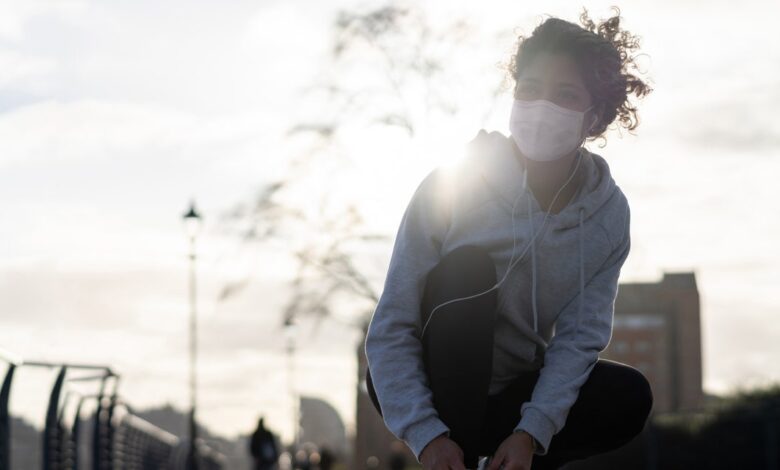What Are the Rules of Working Out When You’re Sick?

It’s that time of year! Colds, the flu, and other gnarly illnesses are swooping in regularly to mess with your neatly planned day-to-day—which, if you’re like lots of exercisers, includes your regular workout. Though you might be tempted to grab some tissues and push through it, it’s actually more important than you may think to give working out when sick a little extra thought.
There’s no one answer to whether or not it’s okay to move your body when you’re feeling gross—it depends on a whole bunch of things, including your symptoms, the workout you had planned, and where you intend to do it. What’s more, the “rules” for exercising when sick have also shifted a bit thanks to everything we learned during the pandemic about how viral illnesses are spread and how much harm they can do. One thing that’s remained true? It’s always wise to listen to your body and respect when it needs rest, Carrie Horn, MD, chief medical officer at National Jewish Health in Denver, tells SELF. That also means there’s never a situation where you have to exercise, especially if you’re not feeling it (for whatever reason, physical or not).
Here are some things to keep in mind for weighing your workout options when you’re sniffly, snotty, or otherwise not feeling your best.
Consider your symptoms—and where you’re feeling them.
Start with a quick symptom check, Jaclyn McKenna, MD, a primary sports medicine physician at the Hospital for Special Surgery in White Plains, New York, tells SELF. Here’s what to keep in mind:
Cold and COVID-19 symptoms
If you’re dealing with “above the neck” symptoms—including congestion, a runny nose, a low-grade headache, or a mild sore throat—your first order of business is to test for COVID-19. Knowing you’re positive (or eliminating the possibility) “can help you make a good decision,” about your workout plans, Alex McDonald, MD, a family and sports medicine physician at Kaiser Permanente in California, tells SELF. (Friendly reminder: You can once again order four free test kits at COVIDtests.gov.) Remember, even if you test negative on the first rapid test, you should repeat it 48 hours later to confirm the result, according to the US Food and Drug Administration. So if you have any “cold” symptoms, you should probably consider your workout paused until you know for sure.
If you’re COVID positive and have only mild issues like congestion or a runny nose, the American College of Cardiology recommends waiting until things clear up entirely before exercising. Test negative twice? Then your symptoms are more likely to be an upper respiratory infection (like a cold), and it’s okay to move your body a bit. Even if you’ve got a light cough that feels more like it’s a tickle in your throat (not chesty), it’s probably okay for you to exercise, Dr. McKenna says. Moderate physical activity shouldn’t make this kind of mild illness feel worse or last any longer, research suggests. Doctors often call this the “above-the-neck” rule, and as long as you’ve ruled out COVID-19, you’re likely okay to continue on with these symptoms—as long as you modify wisely, of course. (More on that later.)
Body aches, fever, chest tightness, and other flu-like symptoms
Symptoms like body or muscle aches, fatigue, fever, a deeper cough, chest pain or tightness, or shortness of breath are all signs you should shelve your workout, Dr. McKenna says. These can signal a more serious systemic sickness, and exercise may worsen that.
For example, fatigue, fever, and body aches can point to the flu or COVID. If you test positive for the latter with these symptoms, you should take at least a week off from exercise, Dr. McKenna says. If you’ve got all that plus a bad sore throat (and are COVID negative), you might be looking at mononucleosis. This requires a more extended break from intense exercise—sometimes as much as three to four weeks—to avoid a ruptured spleen, Dr. McKenna says.
What’s more, a fever can mess with your body’s ability to maintain your temperature and increase fluid loss, so if you add exercise on top of it, you’re likely only compounding both issues, Dr. McDonald says.
Stomach symptoms
Gastrointestinal issues—think vomiting or diarrhea—are also a no-go, Dr. McDonald says. Exercise on its own can be linked to GI woes due to jostling and the diversion of blood flow away from the gut (hello, runner’s trots). So if you combine a workout with an already-rumbling stomach, you might be rolling the dice for a belly blowout—and increasing your chances of getting even more dehydrated.
If you do work out with a little cold, you still shouldn’t work out in close proximity to other people.
If you meet the non-COVID above-the-neck guidelines and really want to work out, know that where you choose to exercise matters. A key lesson of the pandemic is that our choices are about more than our own health—and a little cold that feels like “no big deal” to you could be a huge pain in the ass or worse for someone who is older, immunocompromised, doesn’t have paid sick time, or who just…doesn’t want to feel like shit for several days. So take extra precautions to avoid spewing your germs on other people.
“Nobody wants to be in the gym next to somebody on the treadmill hacking and coughing,” Dr. McDonald says. “Try to be respectful.”
That means working out at home or outdoors, away from other people, when you have symptoms, which indicate an active infection. You shouldn’t go back to the gym or in-person classes until you’re no longer coughing and sneezing and you’ve been fever-free for 24 to 48 hours without any over-the-counter meds like acetaminophen or ibuprofen, Dr. Horn says.
If you want to work out while you’re sick, you’ll still need to dial back the intensity by a lot.
You certainly shouldn’t be running intervals or lifting your heaviest weights while you’re under the weather, even if you just have mild above-the-neck symptoms. Going too hard might stretch out the duration of your illness, and, besides, you’re not going to get that much out of it, Dr. McDonald says.
“The goal of exercise is to challenge your body a little bit, slowly over time, so you can grow and change,” says Dr. McDonald, who’s a former triathlete. But that’s not going to happen effectively if your body is already fighting an illness.
Instead, he recommends backing off and cutting your time and intensity in half—say, a 30-minute walk or easy yoga session instead of an hour-long run or lift. You can also try to switch things up to boost the enjoyment factor: If you had a treadmill session on your sched, you may want to swap that for a scenic stroll in the park instead. “When you’re sick, your mood is pretty down,” Dr. McKenna says. “The purpose of your workout might be to lift you up a little bit, not to necessarily get an intense workout.”
Regardless of what kind of workout you choose, you can expect everything to feel a little harder, given the energy you’re expending battling even a minor bug. “You should give yourself grace and plan to taper back your workout intensity until you feel better,” Dr. McKenna says.
Make sure you drink plenty of water—even a mild illness can make you more prone to dehydration—and monitor your symptoms during and afterward, Dr. Horn says. If you feel worse while you’re working out, stop; if your condition declines after you’re done, rest more the next day, and take it as a sign that you may have done too much too soon. And of course, always check with your doctor if you have any questions about how you’re feeling.
Remember that you never “have” to exercise, especially when you’re not feeling great.
There’s never any obligation to exercise, and sticking to your preplanned programming when you feel like garbage definitely isn’t a sign of strength or “dedication” to your routine. There are tons of good reasons to skip your session when you’re run-down or sniffly—and preferring to stay home with your comfy blanket, cup of tea, and stacked must-watch list is just one of them.
Erring on the side of caution and skipping a workout (or two, or three, or more) can be just what you need to honor your body and prevent you from prolonging your illness or getting anyone else sick. And resting is not going to have any measurable impact on your fitness or strength. “Missing a couple of workouts or a week is not going to be the end of the world when it comes to your long-term health,” Dr. McDonald says. Rather, it could be a valuable opportunity to remember that true strength and wellness sometimes mean holding back rather than pushing through.
Related:



